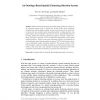379 search results - page 8 / 76 » Order in Space: A General Formalism for Spatial Reasoning |
GIS
2010
ACM
13 years 5 months ago
2010
ACM
Mobile intention recognition is the problem of inferring a mobile user's intentions from her behavior in geographic space. Such behavior is constrained in space and time. Cur...
DIAGRAMS
2004
Springer
14 years 1 months ago
2004
Springer
People sometimes appear to build analogical representations in order to reason about graphical information. In this paper we consider the extent to which the tendency to represent ...
IJAIT
2008
13 years 8 months ago
2008
ion mechanism to create a representation of space consisting of the circular order of detected landmarks and the relative position of walls towards the agent's moving directio...
AI
2009
Springer
14 years 3 months ago
2009
Springer
Spatial clustering, which groups similar spatial objects into classes, is an important research topic in spatial data mining. Many spatial clustering methods have been developed re...
ECAI
2010
Springer
13 years 9 months ago
2010
Springer
Abstract. This paper is centered on the problem of merging (possibly conflicting) information coming from different sources. Though this problem has attracted much attention in pro...

